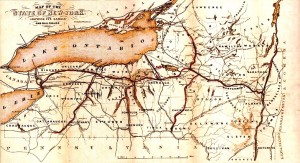During the early 1800s, most transport of goods was confined to using pack animals. In some cases, those animals might draw a cart that could carry more than 250 pounds, but that was about the most one could hope to move any great distance without a great deal of hassle.
New York sought to change that with the building of a canal that would connect the Atlantic Ocean to the Great Lakes. First proposed in 1807, the Erie Canal was originally built to sprawl across 363 miles, and it was designed to be a navigable water route with varying depths to accommodate ships that would pass through.
Building the canal would have a huge impact on industry, lowering the costs of transporting goods by almost 95%. In addition, movement of goods became more efficient. The canal also opened transportation opportunities for people all around the East coast. As a direct result of the canal, New York City became one of the largest ports in the United States.
The canal also helped international trade. New York became the destination for manufacturers to deliver goods, so the canal helped move those goods further into the Western United States. That had the unintended effect of strengthening ties to England, which was ready to import more corn and wheat from the Midwest by the time the canal was completed.
The canal was also a popular travel way for the immigrant population, and has become something of a gold mine for modern day genealogists. Some of those passenger lists have survived in the New York State Archives.
About the Author: Phineas Upham is an investor at a family office hedgefund, where he focuses on special situation illiquid investing. Before this position, Phin Upham was working at Morgan Stanley in the Media and Telecom group. You may contact Phin on his Phineas Upham website or Facebook page.

